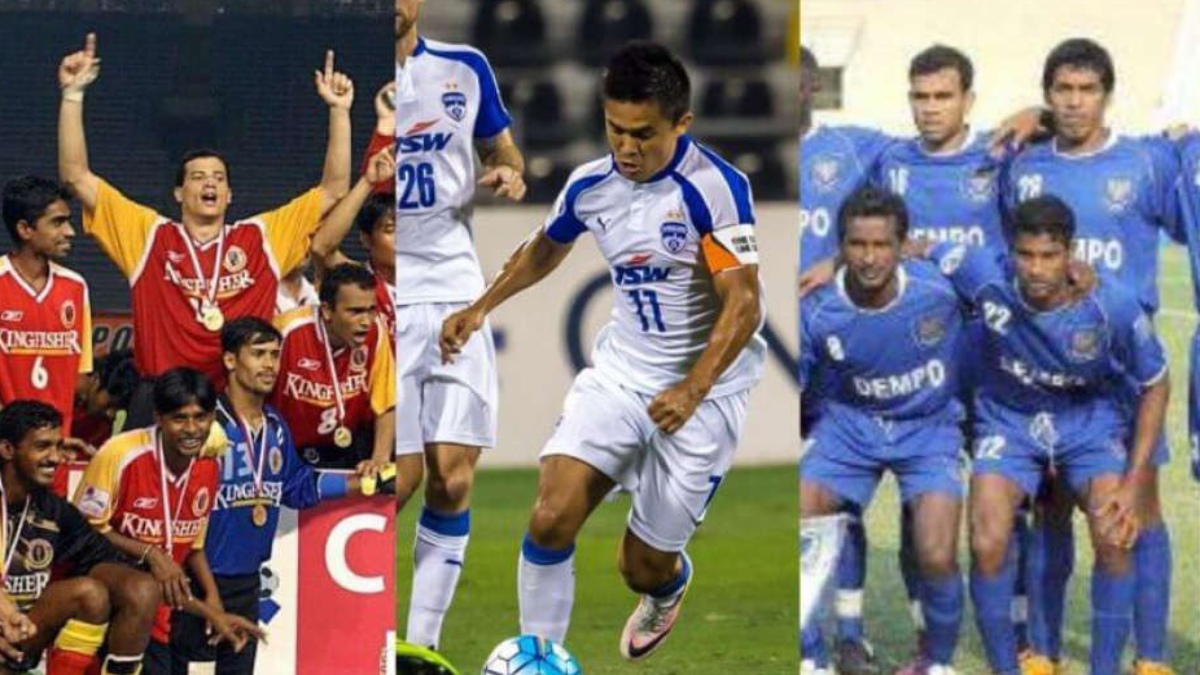


Continental championships are always a special, especially at the club level. It is not every day that the clubs get to fight it out against the best across Asia, and when such moments do come, they are revered by players and fans alike.
Indian clubs have had a memorable past on the continental level, and with ATK Mohun Bagan about to take on FC Nasaf Qarshi of Uzbekistan in the Inter-zone semi-final of the AFC Cup, let’s take a trip down the memory lane and revisit some of those moments when Indian football was proudly carried forward together by the clubs on the continental level.
1969 Asian Champion Club Tournament:
A semi-final run for Mysore state three years after the Indian football team finished runners-up in the AFC Asian Cup 1966, and seven years after the Blue Tigers’ gold medal finish at the 1962 Asian Games, came another proud moment for Indian football in the erstwhile Asian Champion Club Tournament (now known as the AFC Champions League)
The famous Mysore state team that had clinched back-to-back Santosh Trophy titles in 1968 and 1969 was representing India at the Asian level in 1969. Despite losing their first Group A game 0-5 against Yangzee FC of the Republic of Korea, the boys from Mysore slowly paced themselves in the continental level with a 1-1 draw against Bangkon Bank (Thailand), before defeating Vietnam Police (from the erstwhile Republic of Vietnam) and Manila Lions (Philippines), both by a 2-1 margin.
This comeback ensured a route to the semifinal for Mysore state, as they finished second in Group A after Yangzee FC. In the semi-final, however, Mysore lost out 1-6 to Maccabi Tel Aviv, a club that has famously taken part in European competitions like the UEFA Champions League and the Europa League, in recent years.
The 2003 edition of the ASEAN Club Championship has been embedded into the memories of all fans of Indian football (regardless of where their
loyalties lie). This was the first time that an Indian club had won a title on the continental level, truly moving Indian football forward together.
Coming in as invitees to the ASEAN Club Championship, East Bengal had a stuttering start to the tournament, when they suffered a 0-1 loss at the hands of BEC Tero Sasana (Thailand), in Jakarta. However, the Red and Golds came roaring back in their second and final match of Group D, defeating Philippine Army (Philippines) 6-0, with Bhaichung Bhutia netting all the six goals. This win helped ensure East Bengal a passage into the quarter-finals.
Former East Bengal and India captain Bhaichung Bhutia came into his
own in the knockout stage, scoring crucial goals at every stage. Bhaichung and Bijen Singh scored one each in a 2-1 quarterfinal win over Persita Tangerang (Indonesia), before the Sikkimese sniper netted a crucial equaliser in the semi-final against Petrokimika Putra (Indonesia) in a 1-1 draw, which the Red and Golds won 7-6 on penalties.
The final was a revenge match against BEC Tero Sasana of Thailand, who had earlier defeated East Bengal in the first match of the season. This time, however, the Red and Gold Brigade was comfortably in the lead through Mike Okoro’s first half strike, before Bhutia doubled the lead on the other side of the break. Although their opponents pulled one back, Alvito D’Cunha scored a third to ensure the two-goal parity, and the title.
Bhaichung Bhutia had won the Top Scorer’s award, having netted a fabulous nine goals in five matches. Dempo SC had built up a lethal squad during this time, one that clinched five league titles in a space of eight seasons. The period between 2006 and 2008 was perhaps one of the most fruitful periods for the Goan club. Not only did they win two league titles during this time, but they also had a run to the semi-finals of the 2008 AFC Cup.
Pitted against Al-Muharraq (Bahrain), Al-Ansar (Lebanon), and Sur SC (Oman) in Group A, Dempo finished second behind the Bahraini club, to make their way to the quarter-finals, where they beat Home United of Singapore 5-4 on aggregate, over two legs.
The dream run, however, came to an end in the semis, where they suffered a 1-5 aggregate loss against Lebanese side Safa SC. Dempo striker Ranty Martins memorably finished as the third best goal-scorer in the 2008 edition of the AFC Cup, with eight goals to his name.
A decade after the ASEAN triumph, the Red and Golds had a near perfect run in Asia, as they made their way to the semi-finals of the AFC Cup. Pitted against Selangor (Malaysia), Sai Gon Xuan Thanh (Vietnam), and Tampines Rovers (Singapore), East Bengal topped their group without losing a single game.
They made easy work of Myanmar’s Yangon United in the Round of 16, defeating them 5-1, before overcoming Semen Padang of Indonesia 2-1 on aggregate over two legs (1-0, 1-1), thus stretching their unbeaten run in Asia to nine games.
This run came to an end in the semi-final, however, where Kuwaiti side Al-Kuwait, who earned a 7-2 victory on aggregate over two legs. Despite this defeat, East Bengal’s unbeaten run in Asia has gone down in folklore, with striker Chidi Edeh netting six goals for his side.
In recent times, Bengaluru FC’s fantastic run to the AFC Cup Final in 2016 has gone into Indian Football folklore. The Blues had faced some tough challenges along the way, but made their way through to a memorable final in the end.